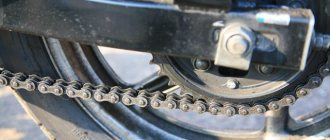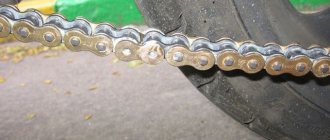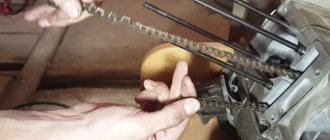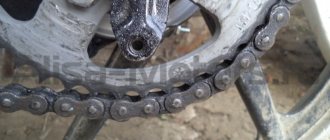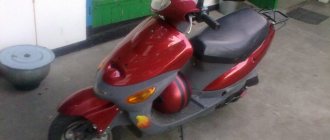Probably every person who has ever seen a motorcycle knows that its structure uses chains, similar to a bicycle. But only motorcyclists understand that the chains are fixed to very important parts - the so-called “stars”. A sprocket is a special gear; for a motorcycle to fully ride, you need 2 stars - a “driver” and a “driver”, one is fixed on the output shaft of the gearbox, and the other on the rear wheel. Thanks to these parts, you can change the traction on the rear wheel and change the maximum speed of the motorcycle - it all depends on the number of teeth on the sprocket; roughly speaking, they determine the gear ratio, which depends on the number of revolutions of the driven shaft to the number of revolutions of the drive shaft.
In order to determine the value of the gear ratio, it is enough to use a simple algorithm - first count how many teeth on each sprocket, and then divide their larger value by the smaller one - this will be the gear ratio and the higher it is, the stronger the traction will be, and, accordingly, the lower the speed.
It is quite natural that all motorcyclists pay a lot of attention to these parts, especially since they wear out quite quickly and need to be changed frequently. Also, since they significantly affect the quality of ride and acceleration, some have several sets, depending on the tasks that the driver sets for himself - perhaps it will be a long trip, or off-road motocross.
After choosing the sprockets for the bike, you also need to select the chain that will stand on these sprockets.
In order to select the optimal chain option, it is worth considering several parameters.
Differences and types of motorcycle chains
Chains vary in type, length and lock. Let's look at each parameter separately and what it affects.
One of the main indicators is the “Motor chain type”, which depends on the dimension or, as they also say, “chain pitch” - this is the distance from which the roller axes are placed. To mark this parameter, a three-digit digital value is used, and it is universal for all manufacturers, for example, 420,525 or 530; for sports motorcycle models, chains 630, 415, etc. are usually used.
In this case, the first number is taken in inches and indicates the distance between each link; to convert this value into millimeters, you simply need to multiply it by 8. The remaining numbers indicate the width that is between the side walls.
Chain length
The length of a bike chain depends on how many teeth there are on the sprockets. The length is as easy to select as the type, since their designations are standard for all manufacturers and depend on the gear ratio.
Chain lock
As a rule, locks are not installed on factory units, since the links are the same size to ensure reliability. But when purchasing a chain for a motorcycle yourself, you need to pay attention that they come in two types with a detachable lock and a connecting link for riveting.
A chain with a riveted link is better suited for use, since a split lock requires special tools and certain skills.
Also, sometimes manufacturers use types of seals, which are additionally indicated on the label in Latin letters.
And of course, there is a huge variety of colors, from classic black to chrome, gold-plated or colored.
Several parameters for selecting stars for a motorcycle:
First, sprockets are measured by the number of teeth.
Increasing or decreasing the number of teeth gives a higher maximum speed and lower acceleration dynamics. Once you know the number of teeth on your motorcycle's sprocket, you can determine a reference number called a "gear ratio" that will tell you exactly what's going on with your motorcycle's drivetrain.
You get the gear ratio by dividing the number of teeth on the rear sprocket by the number of teeth on the countershaft sprocket.
For example, a 49-tooth rear sprocket is divided into a 13-tooth countershaft sprocket, resulting in a 3.77 gear ratio for this gear combination.
This is how many times the intermediate shaft sprocket rotates before the rear wheel makes one full revolution.
Choosing the right gear ratio is a great, inexpensive way to make your motorcycle better, more powerful, and more controllable.
The higher the gear ratio, the lower the gear. Every time the number of gear ratios increases, you decrease the top speed but increase the acceleration.
Conversely, if you want to increase the speed in each gear, you should look for fewer gear ratios. For example, using a 13/46 ratio, the gear ratio would be 3.54.
When figuring out your bike's gearing, it's important to consider your riding style, skill level, and track conditions. For example, a 14/52 gear combination has a gear ratio of 3.71.
But, if a motorcycle owner wants a lower gear, he will most likely add another tooth to the rear sprocket. We get 14/53. This will lower the gear ratio to 3.79 (down from 3.71).
But if the athlete wants the gear to be lower than this, he will be in a difficult position.
Going to a 54-tooth rear sprocket will give it a lower 3.86 gear ratio, but a larger 54-tooth rear sprocket will have problems clearing the chain guide and excessive wear on the chain itself.
In this case, the best solution would be to switch to a 13-tooth countershaft sprocket and pair it with a 50-tooth rear sprocket. This 13/50 ratio will be lower than 14/52 (3.71) or 14/53 (3.79) with a 3.85 gear ratio.
Motorcycle chain maintenance
Motorcycle chains can be classified as consumables that need to be replaced for high-quality and safe motorcycle riding as they wear out. In order to extend the life of a motorcycle chain and reduce the cost of replacing them, it is necessary to properly maintain this part. The motorcycle chain, since it is constantly in contact with the environment, must be constantly cleaned of dirt and provided with a sufficient amount of lubricant on all links. Maintenance of a motorcycle chain is carried out every thousand kilometers, but many experienced owners say that it is necessary to clean and lubricate the chain every 600 km, especially if there is heavy dirt or even just dust on the street.
To care for and clean parts, special motorcycle cosmetics are used, usually in the form of a spray and suitable for various models of equipment. When choosing the type of lubricant, it is necessary to rely on the conditions under which the operation will be carried out.
Also, do not forget that after replacing parts with new ones, a so-called break-in is necessary, during which the centrifugal load on the sprockets increases. Therefore, it is worth carefully selecting the composition of the product, depending also on the speed of the bike, for example, for speeds close to 200 km/h it is worth using special “sticky” lubricants - others will not hold up at such a speed. Or if you plan to drive off-road, then sticky lubricant will not work and it is better to use an aerosol one. The golden rule for applying lubricant to a motorcycle chain is uniformity and no excess; you should also let the lubricant dry a little and allow the excess liquid to evaporate, distributing it throughout the entire chain and do not start the engine immediately after application.
Online program for calculating the chain length when replacing motorcycle sprockets with non-standard ones.
The program, as before, can be easily downloaded here and taken with you on a trip to places where there is no Internet. If you have the Internet, it is of course easier to use an online program to calculate the chain length here on this page. This program is suitable for all types of motorcycles. Its advantage is that even in the most remote wilds of our homeland, if problems arise with the chain, you can try to find analogues of the chain from Soviet motorcycles, which are still very common. We’ll talk separately about the interchangeability of motorcycle chains of different brands later.
First, how to use the program .
In the first four windows we drive in the original chain pitch, the number of teeth of the driving and driven chain, and the number of links in the original. All this information should be found in the manual for your motorcycle. For a Honda cb400 motorcycle on an NC-39 frame, the values will look like this: Original chain pitch: 525 Number of teeth for the drive sprocket: 14 Number of teeth for the driven chain: 44 Original chain length: 108
Then we drive in those values, chains and stars that are being replaced. Let's say we put a driven star on the same sibishka, which is 1 tooth larger. Then we need to enter the following values: Chain pitch (replacement): 525 Number of drive sprocket teeth (replacement): 14 Number of driven sprocket teeth (replacement): 45
We get the length of the new chain to be 109 links. This does not happen, so we round up to 110 units. We always round up to the nearest even number of chain links.
The program automatically changes the maximum speed of the motorcycle when replacing the sprockets with non-standard ones. The general rule is this: the larger the rear (driven) sprocket, the lower the maximum speed, the larger the front (drive) sprocket, the higher the maximum speed. And vice versa.
Chains brand CZ Chains
When choosing the chain itself, of course, you should pay attention to the quality of this part and it is better to choose trusted manufacturers, since a lot depends on the strength of this part. An example is chains from the CZ Chains brand. This is a Czech manufacturer that has been specializing in the production of these parts for almost a century. Constantly improving its technology and using experience, CZ Chains is rightfully the world leader in the production of motorcycle chains. Thanks to the customer focus cultivated by this manufacturer, you can choose a chain for any occasion - the line includes more than 2000 different models.
How to choose the right length sprockets and chain for a motorcycle?
So, let's get straight to the point.
There are only two stars, the driving one, on the engine shaft, and the driven one, on the rear wheel hub. Leading stars are only made of steel. Driven stars come in both steel and aluminum.
Steel sprockets are cheaper and last longer, but are heavier. Aluminum wears out much faster than steel (according to our estimates, aluminum wears 20-50% less than steel, depending on operating conditions), and is considerably more expensive (at the time of writing, the difference between the same sprockets in steel and aluminum versions is about a mower). Aluminum sprockets also come in different colors, for example orange, which should make KTM fans very happy.
Orange star for KTM. Beautiful, especially in combination with a gold chain
There are also composite or bimetallic stars, the “spider” (the part that is attached to the bushing) is aluminum, and the working surface is steel.
Bimetal sprocket from KTM
Such stars move like steel ones, but at the same time they weigh lighter (although heavier than pure aluminum ones). Their disadvantages:
- Horse price. According to the latest data, our Chinese colleagues have begun to make bimetallic stars, but we are not in the know, we are trying not to get involved with the rice guys unless absolutely necessary.
- Limited choice. Not all motorcycle models have bimetallic sprockets.
Important! Sprockets and chain work and wear together! If you change the chain, you also change the sprockets!
Therefore, you need to choose stars based on the chain that you have chosen based on the conditions of use. When choosing the lightest sealless chain for racing use, there is no point in installing a steel sprocket, you will negate all the benefits gained from a light chain, and the chain will wear out much earlier than the sprocket. Be consistent - use aluminum! Yes, for one race, but we need a victory, we won’t stand for the price...
You should not install an aluminum star on the seal DID 520ZVM-X. Z-ka is the strongest and most durable of all 520 chains, use steel!
You can read more about the differences between specific models of DID chains and the options for choosing chains and stars in our article.
How can I find out which specific sprockets will fit my motorcycle?
In addition to the material of manufacture, the stars also differ in their mounting dimensions, the number of mounting bolts, their diameter and the number of teeth.
You can find information about which sprockets are suitable for your motorcycle in the catalog of sprocket manufacturers, such as PBR or JT.
To use the catalog, you must know EXACTLY the model and year of manufacture of the motorcycle!
PBR star catalog
JT star catalog
Selecting stars from a catalog is not a simple matter, full of nuances, subtleties and pitfalls. This is especially true for motorcycles produced before 2000 and models for the domestic Japanese market. For example, the well-known and beloved Suzuki DRZ400 has different rear wheel hubs in the European version and in the Japanese version, and different sprockets that are not interchangeable. A star from Europe will not stand on Japan and vice versa. Or the motorcycle has a non-original rear hub, then the star according to the catalog will not fit on it...
If you have doubts about the correct choice of stars, entrust it to professionals so that you don’t feel bad about wasted years and wasted money.
If we choose the wrong sprockets for the bike, we will replace them at our own expense, including postage!


